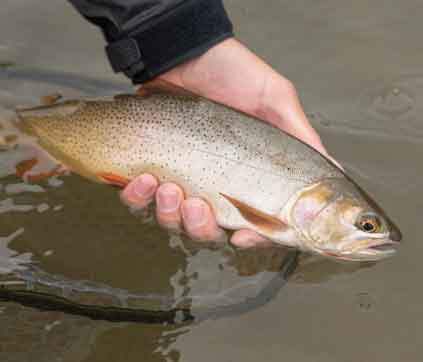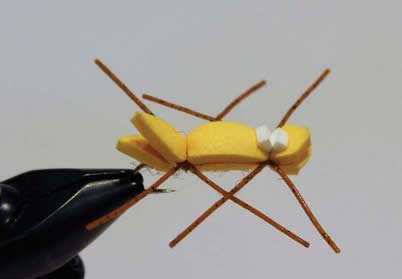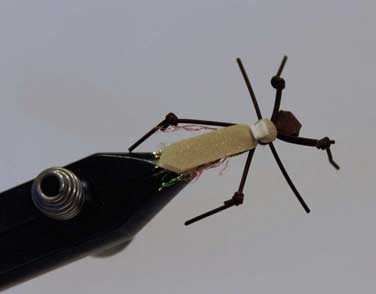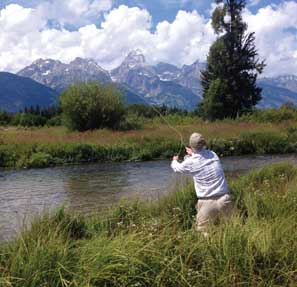An in-depth look at fine spotted cutthroat fishing in Jackson Hole
By David Riley Bertsch
WE’RE LAUGHING. Cracking up really, because the fishing is just that good. It wasn’t supposed to be like this. It was too early. May-something. The water was too cold and the kind of milky green that only a Steelhead can love. There were no bugs whatsoever. It was our first day of the season floating the Snake River in Grand Teton National Park, and we’d primarily set out to see what had changed during runoff – which channels had closed, which old ones may have re-opened, and where a new deadfall might attract a day-making fish. As for catching, our expectations were low.
You know what they say about the best-laid plans. It was good. Darn good. Like fifty some native fish on big garish dry flies kind-of-good. As we drive back to town, the cathedral group towers to our west soaking up the last rays of sunshine. A mama moose nudges her calf away from the road. I ask myself: Can it get any better?
I was stumped. Still am, in fact.
The Snake River is a gangly serpent indeed. From its origins in Yellowstone, it slithers southwest over ancient bedrock, touting various world-class fisheries along its course: trophy trout on the South Fork, smallmouth bass on the main stem, and finally, near its confluence with the mighty Columbia, steelhead, salmon and the prehistoric sturgeon.
Each of these fisheries stand out in their own right, but perhaps none so virtuously as the Upper Snake in its reaches from Jackson Lake Dam to Palisades Reservoir. Here, a vibrant knickknack of a fish lives on – the Snake River Fine Spotted Cutthroat. According to fossil records, Cutthroat trout have existed in the Snake River drainage for somewhere in the range of 4-5 million years, and thus have endured the perils of an ever changing climate, logging, fur-trapping, gold-mining, industrialization and over-fishing. Still, on an August day with grasshoppers beating their wings amongst the streamside willows and Pale Morning Dun’s dotting the slicks, you might start to wonder if these colorful bantam-weights even noticed we were here.

As a destination fishery, the Upper Snake still gets its fair share of flak. The river is a black sheep among rocky mountain tail waters, compared to engineered eco-systems that fatten and strengthen stocked fish. Below Jackson Lake dam, the Snake fishes as it historically should – like a high mountain freestone river, and all the good and bad that go with it. Fine-Spots are recurrently persecuted for their size — a good one is 15 inches and up — and they’re not always the scrappiest fighters in the world.
But to accurately weigh a Fine-Spot, one must consider all of its attributes. Plentiful? Check. It’s not uncommon for a good angler fishing out of a boat to catch forty-plus fish in a six-hour day. Beautiful? Check. See exhibit A. Surface oriented? Check plus. In one hundred days of fishing the Snake per year, I can basically count the fish I catch subsurface using fingers and toes.
I don’t mean to suggest the Snake River is fool-proof, but armed with the right gear and information, it may very well leave you to wonder, Is there anywhere better.
How
Let’s get one thing out of your head: Snake River Fine-Spotted Cutthroats are not exactly easy to catch. Because reproduction is strong, anyone with a hackled hook between sizes two and twenty-two and a bottle of gink can wade into a calf-deep riffle and tear the yearlings up on the Snake. There’s nothing wrong with that, if you are using barbless hooks. The larger fish, even those just 12” and above, can be somewhat enigmatic, particularly to anglers who are more acquainted with browns and rainbows.
Bigger Cutties are lazy coots for the most part, preferring dawdling currents and deep holes to ripping banks and heavy pocket water. Remember that the Snake is generally cold and well aerated, so its trout aren’t forced into the fastest water. As a result, deep, soft insides and slow banks are moneymakers. A dry-fly cast into what you think is no-man’s land might just get annihilated if you leave it long enough. A large fine-spot needs time to mull over your presentation in slack water, waiting to make sure he’s not being duped. In this situation, it often pays to let the 6 inchers eat and spit out the fly without setting the hook.

One exception to the slow water rule is where currents of varying speeds collide in a current seam or fast pour-over. These areas appear raucous from the surface, but thanks to a phenomenon called a hydraulic jump, a calmer swirling flow develops beneath and just downstream of the collision point. Large Cutties love to call these “jumps” home. Chuck a foam hopper into the chaos and hold on.
Perhaps the most rewarding way to catch larger Cutthroats on the Snake is spotting and stalking in skinny side channels. This requires a measure of finesse reminiscent of spring creek brown trout fishing. Leave the foam flies in the boat, and only bring along finer tippets and low-profile mayflies in the #14-18 range. An 18 inch trout will happily live in a channel narrower than your wingspan, especially if there is spring influence or an easy escape route nearby.
Walk carefully upstream, wade only when necessary, and assume a safe casting range is about twenty-five feet. These fish eat slowly and deliberately and you will only have one – maybe two – shots, so make it count. It’s safe to say that a large portion of the trophy fine-spots from the Snake are caught under these circumstances on small dry flies.
On the subject of flies, I rarely fish anything that isn’t foam or a parachute-style mayfly. Sure, there are exceptions, and we all have our favorite secret flies for picky fish (ahem, small Formica imitations), but for the most part a Chubby Chernobyl style Ant between size 6 and 14 and a selection of smaller parachutes in various tones will do the trick.
For foam flies, I much prefer those with a dubbing body than segmented foam body types. The untidy fibers furnish a buggy look that segmented foam lacks. Purple, red, pink and gold are my favorite colors, and the patterns I use almost always include some element of sparkle in the dubbing and tail. UV dubbing never hurts. A high-vis antron wing is helpful for the some fisherman, but there are times when I find a lower sitting fly to be more effective. Variations on the Chubby Chernobyl like Will Dornan’s Water Walker and Circus Peanut can outperform the basics on tough days. I usually fish these flies on the small side — #10, #12 or even #14 if I can find them, especially later in the season.

At times when I find an even smaller fly necessary, my go-to is a Borcher’s Parachute Moose Tail. This fly is essentially a Parachute Adams, but with a darker tail of moose hair, a segmented body and a more fibrous dubbing that lends a buggy, disheveled look. From sizes 10-20, it can reasonably imitate any hatch on the river.
If things really need fine-tuned, I’ll fish a Tilt-Wing Pale Morning Dun, or a Brooks Sprout Emerger to imitate the plentiful Mahogany Duns. Both of these parachute-style flies float well and are reasonably visible.
The most important thing on the Snake is to not overthink your fly choice. Try foam in likely water and if you aren’t satisfied, go with the Moose Tail. If you see sippers and/or keep getting refusals, tie on a more specific mayfly pattern.
As for rods, all you need is your 9-foot five weight. A fast action blank helps in the afternoon wind. A nine-foot 3x leader with tippets from 3x to 5x will cover your dry-fly needs — Snake River Cutthroat are not generally tippet shy. Focus instead on your presentation.
When
Weather in Jackson Hole is extremely volatile from Early October to Late June. This is not to say that fishing can’t be outstanding during that time, just that if you are traveling from afar, you could lose valuable fishing time to inclement weather. The safest months as far as weather and water clarity are August and September. July can be outstanding, but if the Tetons receive above average snowfall, the water may still be high and milky green due to snowmelt. Call a local fly-shop before you come to check the conditions. October can be similarly spectacular, but beware of weather and the fact that the Jackson Lake dam’s flows will dwindle at some point during the month, displacing fish and making for at least a few challenging days.
Instead of changing with specific insect hatches, I find the Snake River to vary in general moods. For instance, as soon as the river clears, I will often fish a foam fly in sizes 6-10. As the summer wears on I downsize my foam selections until sometime in mid-August, when I almost always start with a parachute Moosetail, size 14. There are days in early September where I will begin with a Brooks Sprout emerger or a Tilt Wing Dun and go from there.
Most years, the Snake’s Cutties will go back on foam sometime in mid-September as their metabolism increases with the oncoming winter, but this isn’t always the case. If this occurs, I find my best success using flies like the Water-Walker that give the fish a fresh look at foam.
Where
The Snake River can be floated in a drift boat from the Jackson Lake Dam to West Table Boat ramp, south of the Town of Jackson. If you aren’t an experienced rower, a good guide is important – deadfalls and fast current lead to accidents every summer in Grand Teton national Park. Below South Park Bridge, the river slows considerably and is best-fished early and late season when water temperatures make the fish sluggish, or when cloud cover ignites a mayfly hatch.
The most popular fishing sections are the four between Pacific Creek and South Park Bridge, where side channels and plenty of bankside structure offer prime habitat. When runoff blows out the river, the short section between Jackson Lake Dam and Pacific Creek can offer clear water and rising fish.
Pacific Creek to Deadman’s Bar
Starting at Pacific Creek boat launch just inside the Grand Teton National Park Moran Entrance, the Snake is characterized by relatively lazy currents and a single, main channel as it flows south towards Deadman’s bar.. Here, look for fish on messy deadfalls and grassy banks. A mile after the put-in, the river begins to braid. Many of these first channels are too skinny to navigate in a drift boat, but anchoring and wading can be productive. The river then pours again into a single channel, where high gravel “hopper” banks hold good numbers of average sized cutthroats. When boat pressure is high, any medium sized tungsten beaded-nymph 16 inches under a foam dry will pass the time between rising fish against these high walls.
This section, between Pacific Creek and Deadman’s Bar, is over ten miles, so don’t dawdle. The last half of this section features a brisker current, various braids, and several tributaries. This is mayfly country from mid-July until the first freeze. Often, a size #14 or #16 Moose Tail is all you need.
Deadman’s Bar to Moose
The float between Deadman’s Bar and Moose junction is a personal favorite. It is short and fast, but complimented by tributaries, sloughs, spring creeks and riffles. When I fish this section, I expect to spend at least a couple of hours out of the boat, looking for mayfly eaters in calm sloughs and pitching foam flies into crashing hydraulics. In the main channel, almost every bank will produce with a Chubby Chernobyl trailed by a #14 or #16 parachute.
Halfway through the section, the river braids into what locals call “the maze” and really begins to pick up steam, which it will carry almost the entire way to South Park Bridge downstream from the town of Jackson. Many side channels are too shallow or tight to navigate. If you stay in the main stem and follow the boat traffic, you can always anchor and walk back upstream to a good-looking hole. A big trout is not worth your life.
Moose to Wilson Bridge
The lengthy stretch between Moose Junction and Wilson Bridge is your best bet to catch great numbers of large Fine-spots. These thirteen miles of the Snake run through a myriad of side channels, riffles and ebullient banks. Again, a foam fly trailed by a more imitative dry is the go-to. The river here, can be dangerously swift, so be sure to read the water carefully. For whatever it’s worth, The Jackson Hole One Fly tournament is almost always won on this section.
Below Wilson, the river continues at a brisk pace until the take-out at the South Park Bridge. There is no shortage of larger fish here either, but expect them to be choosy as fishing pressure is heavy . Also note that in recent years, landowners in this stretch have seen an increase in trespassing and are less forgiving of wayward fisherman. If you need to anchor and get out, please do so on an island across the channel from a rock-levee wall. The regulations on exiting the boat between Wilson and South Park are currently evolving, but anchoring on a mid-river island between levee walls is legitimate as of this writing. If a landowner disagrees, apologize and pull anchor quickly so as to avoid stricter regulation in this high-use area.
The sections downstream from town: South Park to Astoria and Astoria to West Table feature slow, long pools punctuated by river-wide riffles. Fish the banks and the broken water with a Chernobyl style ant or a Parachute Moosetail. When there is cloud cover, Baetis, PMD’s and Mahogany duns can hatch in great numbers.
It is possible to float and fish the whitewater section of the Snake River Canyon from West Table to Sheep Gulch, but only with an accomplished oarsmen who is familiar with the river.
Wade fishing is best in Grand Teton National park, where all land is public and boat ramps and other access points provide plenty of opportunity.
Some of my favorite walk-in spots include Blacktail Ponds, just north of Moose Junction, and River Road, which departs off of the interior park road between the Taggart Lake trailhead and the Climber’s Ranch. Both of these access points feature various spring creeks and tributaries as well, but be aware that seasonal regulations differ between the Snake and its tributaries to protect spawning trout. Always check the regulations before you go.
Downstream from the National Park, wading is best near the Wilson Bridge on Highway 22. Two public levees provide access here. In combination, these walking paths provide four miles of good bank access. At summer flows, the Snake in this section is eminently wade-able. On the East side especially, the river is sinewy and diverse. Side channels and confluences provide endless holding water.
Further downstream, walking in is easiest via the boat launches: South Park, Pritchard, Elbow and East Table. West Table launch provides decent access, but the area is overrun with launching white-water rafts during the high season.
Surrounding Waters
Jackson Hole is Shangri La for the dry fly fisherman. In addition to the Snake River, there are countless streams and lakes brimming with native fish in every direction. Most of the better water is easily accessible. For starters, try the Gros Ventre or Hoback Rivers and their tributaries. Both of these smaller rivers have excellent park-and-wade access from the roads that follow their course. The same flies and techniques used on the Snake are effective. The Hoback even boasts a Salmonfly hatch in early July. Blacktail Ponds and Flat Creek offer sight fishing to large Cutties, but be aware of seasonal closures.
If you’re feeling more adventurous, pitch a tent high up on the Gros Ventre road and explore its many tributaries. The highlights include Fish Creek, Cottonwood Creek and Crystal Creek.
In Grand Teton National Park, try Pacific Creek and the Buffalo Fork.
When You Go
Jackson Hole is an enormous tourist draw. There are endless lodging options. Stay in town if you want restaurants and watering holes.
Grand Teton National Park hosts comfortable, facilities, and the location is prime for fishing the snake. For more primitive camping, Gros Ventre road has various pull-offs and established campgrounds. Always be aware of bears and store your food accordingly.
There are a dozen or more outfitters in and around the town of Jackson that offer guided fishing on the Snake River.
When you book, make sure the outfitter has permits to fish all the best water. It’s always smart to explain your expectations and experience level to the outfitter before you arrive.
David Riley Bertsch is a fly-fishing guide and writer in Jackson Hole. He has published two fiction novels, “Death Canyon,” Scribner, 2013 and its follow-up, “River of No Return,” Scribner, 2015.

